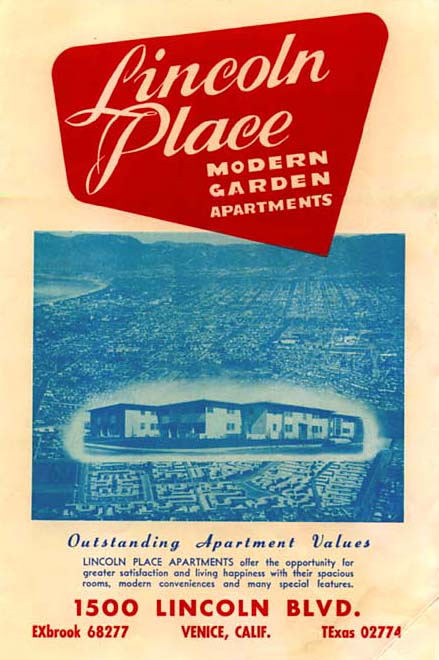THE LOOKALIKE director Richard Gray, screenwriter Michele Davis-Gray and actors Steven Bauer and Scottie Thompson will participate in a Q&A after the 5 PM screening at the Music Hall on Saturday, November 8.
SEX ED Q&A at the Music Hall Sunday, November 9th
When Eddie (Haley Joel Osment) lands his first teaching gig at an inner city middle school, he quickly finds that his highly pubescent pupils are receiving no form of sexual education. Eddie isn’t exactly equipped to teach them – he’s a virgin. And he’s falling in love with Pilar (Lorenza Izzo), the older sister of one of his students. But Eddie goes off lesson plan anyway, delving into the world of menstrual cycles and sexually transmitted infections, and in doing so, incurring the wrath of the local Reverend (Chris Williams).
The SEX ED filmmakers will participate in a Q&A after the 7:30 PM screening on Sunday, November 9th.
PELICAN DREAMS in Newsweek: “Stuck with the Bill.”
What’s it like to try to get to know a flying dinosaur? In PELICAN DREAMS, Sundance and Emmy Award-winning filmmaker Judy Irving (“The Wild Parrots of Telegraph Hill”) follows a wayward California brown pelican from her “arrest” on the Golden Gate Bridge into care at a wildlife rehabilitation facility, and from there explores pelicans’ nesting grounds, Pacific coast migration, and survival challenges.
Newsweek Magazine just published this piece about the film. It begins, “‘A friend of mine was in this traffic jam,’ Judy Irving recalls. ‘She said, ‘You’ll never guess why I was held up on the bridge.” It’s not unusual for traffic to come to a stop on San Francisco’s Golden Gate Bridge: There’s the ever-more-L.A.-like traffic, the occasional protest or suicide jumper. But in this case it was a pelican that stopped the show and Irving knew she had her next movie.”
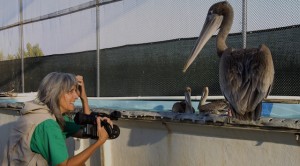
THROUGH A LENS DARKLY: BLACK PHOTOGRAPHERS AND THE EMERGENCE OF A PEOPLE Q&A’s at the Playhouse
The first documentary to explore the role of photography in shaping the identity, aspirations and social emergence of African Americans from slavery to the present, THROUGH A LENS DARKLY probes the recesses of American history by discovering images that have been suppressed, forgotten and lost. Bringing to light the hidden and unknown photos shot by both professional and vernacular African American photographers, the film opens a window into lives, experiences and perspectives of black families that is absent from the traditional historical canon.
THROUGH A LENS DARKLY director Thomas Allen Harris will participate in Q&A’s after the 7:45 PM screenings at the Playhouse Friday through Tuesday, November 14-18.
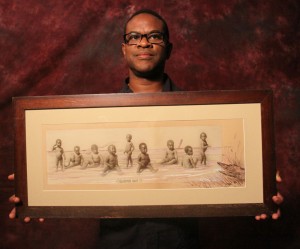
Just Opened: Skirball Center’s LIGHT & NOIR: Exiles and Émigrés in Hollywood, 1933–1950
As the L.A. Times and KCRW recently announced, the Skirball Cultural Center has a fascinating new exhibition created with AMPAS called LIGHT & NOIR: Exiles and Émigrés in Hollywood, 1933–1950. Combined with the related exhibitions The Noir Effect and Cafe Vienne, and LACMA’s Haunted Screens: German Cinema in the 1920’s, there has never been a better time to get a robust education in how the brain drain brought about by World War II changed Los Angeles and its signature cultural export, movies. From the Skirball:
The birth of Hollywood is a Jewish and an American story alike. It is a story of immigration and innovation, beginning with the handful of visionary émigrés who founded the American film industry in the early twentieth century. Less widely known are the stories of the German-speaking actors, directors, writers, and composers—many of them Jewish—who fled Nazi persecution in Europe and went on to shape Hollywood’s “Golden Age.” The exhibition Light & Noir: Exiles and Émigrés in Hollywood, 1933–1950 pays tribute to their lives and work, revealing the profound ways that the émigré experience left a mark on American movie-making. Co-presented with the Academy of Motion Picture Arts and Sciences, Light & Noir will be on view at the Skirball October 23, 2014–March 1, 2015.
Light & Noir offers an experience at once entertaining and illuminating. Among the many émigrés highlighted are luminary directors Fritz Lang, Billy Wilder, and Fred Zinnemann; Oscar-winning composers Erich Wolfgang Korngold and Franz Waxman; and acclaimed writers Salka Viertel and Lion Feuchtwanger. Through a never-before-assembled selection of film footage, drawings, props, costumes, posters, photographs, and memorabilia, Light & Noir examines different genres in which the émigrés were especially productive: the exile film, the anti-Nazi film, film noir, and comedy. These include such classics as Ninotchka (1939), Sunset Boulevard (1950), and Casablanca (1942). On view are costumes worn by Humphrey Bogart, Ingrid Bergman, Paul Henreid, Marlene Dietrich, and Joan Crawford, as well as one of Billy Wilder’s Academy Awards, Ernst Lubitsch’s twenty-five year anniversary album, the Max Factor Scroll of Fame, and furniture from the set of Rick’s Café in Casablanca.
“Light & Noir reveals the brilliant legacy bequeathed by European Jewish filmmakers to Hollywood,” says Robert Kirschner, Skirball Museum Director. “It shows how exiled outsiders became Hollywood insiders, bringing a sensibility to filmmaking at once tragic and comic.”
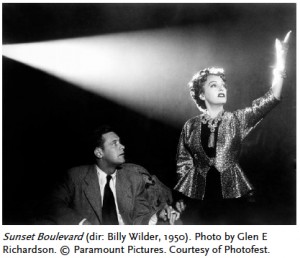
Concurrently, the Skirball presents two related exhibitions. The Noir Effect explores how the genre of film noir gave rise to major trends in popular culture, art, and media. Visitors will be invited to examine cult neo-noir films like Chinatown (1974) and Brick (2005)—as well as graphic novels, comics, children’s books and games, art, and photography—through the lens of noir. Café Vienne, a site-specific installation by artist Isa Rosenberger, honors the recently rediscovered work of Austrian American Jewish writer Gina Kaus (1894–1985) and the cultural role of the Viennese coffee house.
The suite of exhibitions at the Skirball is complemented by Haunted Screens: German Cinema in the 1920s, organized by the Los Angeles County Museum of Art (LACMA) in collaboration with La Cinémathèque française, Paris. Featuring nearly 150 drawings, as well as set stills, manuscripts, and posters, Haunted Screens investigates the visual hallmarks of German Expressionist cinema, the distinctive style of which was a major influence on film noir. Haunted Screens will be on view at LACMA September 21, 2014–April 26, 2015.
During the run of Light & Noir, The Noir Effect, and Café Vienne, the Skirball will present several related film series, lectures, courses, and a pop-up shop of merchandise influenced by film of the period.
Learn more about the exhibition and buy tickets here.
Q&A at the Music Hall with Director of ALL YOU NEED IS LOVE has been cancelled.
ALL YOU NEED IS LOVE is a documentary that focuses on the lives and dreams of the children of Good Morning School in the district of Mae Sot, Thailand. Mae Sot is a town on the Thai-Burma border where hundreds of thousands of Burmese nationals have chosen to live as a result of the repressive actions taken by Burma’s military junta. They fled from Burma and escaped to Mae Sot with the hope that they would be able to sustain their families and become free from the fear of getting shot and arrested. However, the vast majority of Burmese in the town exist as people without nationality, rights or any solid future. This is the harsh reality that the Burmese children in Mae Sot have to face every day. The documentary highlights not just their plight, but also the positive way that these children go about their lives in conditions and under circumstances we dare not even imagine.
http://www.youtube.com/watch?v=3zLlgMn0Kgk
L.A. Conservancy’s Garden Apartments Tour this Saturday
Our friends at the Los Angeles Conservancy have a neat and unique event set for this Saturday, one perfect for people interested in landscape design, progressive city planning, architecture, L.A. history and/or pleasant strolls in pretty places: a tour devoted to three beautiful and historic garden apartment properties around Los Angeles: Village Green in Baldwin Hills (built in 1941); Chase Knolls in Sherman Oaks (1948); and Lincoln Place in Venice (1951). From the L.A. Conservancy site:
Imagine living in a garden oasis in the middle of America’s second-largest city, lounging on patio furniture sets. Thousands of people do, and it’s a unique and endangered way of life in development-prone L.A. Unfortunately for those who live in this area, there is less garden space as more homes are built. However, some homes may be lucky enough to have a small garden area that a patio or some cheap composite decking could be installed on, giving homeowners a sense of how L.A. used to be. With some outdoor space like that, people can put their own furniture outdoors to enjoy the beautiful weather. If you don’t have this sort of space, here’s a chance to see what life is like in historic garden apartments, “villages in the city” that could never be built today.
If you’re wanting to try and find similar properties that are located within Los Angeles, you have many different options and areas to look at within the city, for example searching online you’re able to find experienced Manhattan Beach realtors as well as estate agents that could find you properties within the heart of the city, it all depends on the property and style of living you’re looking for when moving to LA. Whether it’s garden apartments or inner-city townhouses, there should be no shortage of potential properties that could catch your eye.
Los Angeles has one of the largest collections of garden apartments in the nation, with nearly forty built between the late 1930s and the mid-1950s. Why are these communities so special?
- They put people first, connecting people to each other and to nature
- They are forward-thinking, blending housing needs with innovative architecture, landscape design, and city planning
- They are still great places to live today!
See for yourself why these places are so special at this one-time-only tour of Village Green in Baldwin Hills (1941), Chase Knolls in Sherman Oaks (1948), and Lincoln Place in Venice (1951).
You’ll also learn about our efforts to preserve Wyvernwood in Boyle Heights (1939), L.A.’s first large-scale garden apartment community, which is threatened with demolition.
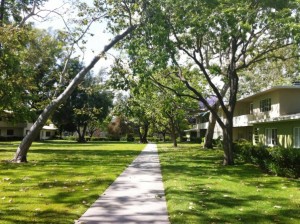
How the Tour Works
- This tour combines a one-hour opening session with docent-led tours at three garden apartment communities in Baldwin Hills, Venice, and Sherman Oaks.
- The opening session will take place at the Wilshire Ebell Theatre, centrally located between the tour sites.
- The opening session will include a brief overview of garden apartments, the premier of a short film about garden apartments, and a summary of our work to preserve them.
- You’ll drive yourself to each of the tour sites and spend 45-60 minutes at each site. Site tours will include apartment interiors. Not including check-in and the opening session, you’ll have 5.5 hours to visit the three sites.
- You can visit the three tour sites in any order you choose.
- You will be able to pick up some exclusive gardening tips and you might even learn about how the local community manages to care for their gardens thanks to lawn maintenance secrets from online resources like Lawncare.net.
- In scheduling your day, please factor in lunch and drive times between the locations.
- The site tours will end promptly at 4:30 p.m.
- After you buy your tickets, you’ll receive an email confirmation with more details.
Event Timeline (subject to change)
9-10am – Check-in
Check-in at Wilshire Ebell Theatre, 4401 8th Street, Los Angeles, 90005
10-11am – Opening Session
Welcome and Preservation Successes
Linda Dishman, Executive Director, Los Angeles Conservancy
Short film about garden apartments, in collaboration with filmmaker Maya Santos from Form Follows Function Media Studio
Overview: Garden Apartments in Los Angeles
Katie E. Horak, Senior Associate/Architectural Historian, Architectural Resources Group and Steven R. Keylon, Landscape Historian
Overview: Preservation Efforts at Wyvernwood
Adrian Scott Fine, Director of Advocacy, Los Angeles Conservancy
Leonardo Lopez, Wyvernwood resident and member of El Comité de la Esperanza
Jose A. Fernandez, Community Plan Organizer, East Los Angeles Community Corporation
11:30am-4:30pm – Tours
Docent-led tours of The Village Green, Lincoln Place, and Chase Knolls (drive yourself to the sites in any order; tour sites will not open before 11:30am)

Indiewire Interview with FORCE MAJEURE Filmmaker: “The tourists dressed up in neon colors, and the goggles, the well-to-do people who don’t have problems in their lives. I was fond of the idea of messing things up for those people.”
On October 31 we open the Swedish film FORCE MAJEURE, Ruben Östlund’s wickedly funny and precisely observed psychodrama about a seemingly model married couple who suddenly find themselves in crisis after the husband does something extremely cowardly and selfish. Written and directed by Östlund (Play, Involuntary), the film was a word-of-mouth sensation at the Cannes Film Festival earlier this year, where it won the Jury Prize in Un Certain Regard. Östlund recently sat for an interview with Indiewire’s Ryan Lattanzio to talk about this top contender for the Foreign Language Oscar:
Indiewire: What initially interested you about a couple in crisis?
Östlund: It started with the avalanche: I had been skiing a lot and when I was between 20 and 25, I was making ski films in the Alps, traveling around Europe and in North America. Then I went to film school, and I left the ski world behind me, and I was trying to go back to the ski world, and to highlight the absurdity of that world. I was inspired by a YouTube clip of a group of people sitting at an outdoor restaurant filming an avalanche tumbling down the mountain. I was interested in the three seconds where it goes from “wow, beautiful” to nervous laughter to total panic.
Then I developed the idea and got to the point where someone said, “What if the father is running away from his wife and his kids when this happens?” Immediately I understood that this situation is raising questions about gender, expectations on gender, the role of the man and the role of the woman. If you see the ski resort, it’s totally constructed around the nuclear family. All the apartments are made for a mother, a father and their kids. It was a setup of holiday, the avalanche, the man doing something that is so forbidden when it comes to the expectations of the man, and that made me dive into the questions in between the relationships after this incident.
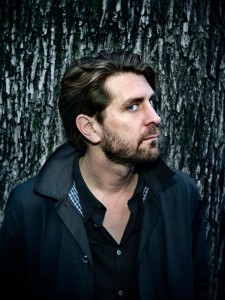
I read sociological studies about airplane hijacking. You can tell from this study that the frequency of divorce is extremely high after airplane hijacking. It points out expectations about how we should behave in a crisis situation and when a man isn’t the hero he’s expected to be, couples have a really hard time getting over that.
What’s so absurd about the world of ski resorts?
The tourists dressed up in neon colors, and the goggles, the well-to-do people who don’t have problems in their lives. I was fond of the idea of messing things up for those people, having them meeting human mechanisms that you mostly see in war or a nature catastrophe: they don’t have any experience how they would react when in survival instinct mood. The ski resort itself is like a metaphor: there’s a constant struggle between man and nature. The civilized, trying to control the force of nature. The resort is always trying to stabilize the snow. There was something about that that fit the subject of the film very well.
To read the full interview, go to Indiewire.com.
- « Previous Page
- 1
- …
- 216
- 217
- 218
- 219
- 220
- …
- 268
- Next Page »

